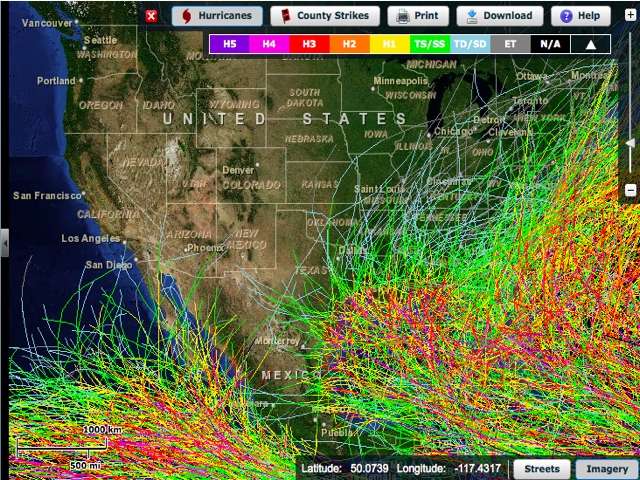

I do get what I wanted, after all: current severe and life-threatening tornado warnings and watches with radar progression images. Since I don’t do forecasting, stills are just fine, even if it would be cool to play around with model future progressions. The app does give continental US and regional stills from Tropical Tidbits: wind, barometric pressure lines, and other nifty weather nerd graphics. I don’t know enough about weather to know if I am missing out on satellite imagery showing my location in the Midwest. I might need a different app for winter weather season. I know little about forecasting, but I know enough to recognize that this app includes visual tools that forecasters use to discuss weather.

I like being able to see the continental US radar view. This app is much easier to read (font size) than using an iPhone 6 web browser to view SPC, NOAA or NWS websites for first-hand info. So bear with me as I extol the virtues of the app as a noob to weather stuff. I may seem excited, and I am a little bit giddy. GIS was used after Hurricane Maria devastated Puerto Rico in 2017 to track which parts of the island had lost power, cell service and access to potable water, and after Hurricane Irma, also in 2017, to map out flooded parts of Florida’s Gulf Coast.This is my first time using any app to access continental US severe weather warnings and watches in one place. In 2017, survivors of Hurricane Harvey in Texas created pins on Google maps and added attribute data like ‘Woman in Labor’ to help first responders. Geographic Information Systems (GIS) can change that, allowing locals and responders to work together to create real-time maps and data systems to help save lives. Historically, emergency responders have mapped hurricanes to try to prepare and target their responses, but relying on traditional physical maps that are not updated in real time can limit how effective those responses are. Each created massive destruction on the Gulf Coast of the U.S. These two destructive hurricanes occurred less than a month apart from each other in the late summer of 2005. Did You Know?Wind speeds are just one factor in the damage a hurricane can cause–the other is the water that a storm can push onto land, called a storm surge, which can cause flooding.Ī typical year has three major hurricanes. Then compare the second set of maps to the first and analyze the changes in trajectory that can happen within a single 24-hour period. Repeat the mapping process, but instead of choosing one point from each 24-hour period, map out all four coordinates from each day.Once complete, compare and analyze the different paths of the two hurricanes.You can read more about pressure systems and fronts at the National Weather Service. Cold fronts lead a low-pressure system, and often cause more drastic changes in weather conditions. Fronts are the leading edge of a pressure system. Another type of weather term to know: Cold fronts and warm fronts. Did you know? Low-pressure and high-pressure systems aren’t dangerous by themselves but can lead to more dangerous storms. Repeat this process on the other map for Hurricane Rita.But hurricanes often are more dangerous and cause more damage because of the sheer size and scope, and also because of the flooding they produce.

Did you know? A tornado can have much higher wind speeds than a hurricane, with top speeds reaching up to 260 m.p.h. Category 1 is the lowest at 74 m.p.h to 95 m.p.h Category 5 is the highest at 157 m.p.h. Hurricanes are rated on a scale of one to five based on their wind speeds and the potential damage they can cause.


 0 kommentar(er)
0 kommentar(er)
